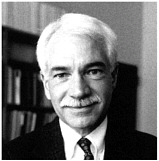The Space Studies Board is a unit of the National Research Council, which serves as an independent advisor to the federal government on scientific and technical questions of national importance. The Research Council, jointly administered by the National Academy of Sciences, the National Academy of Engineering, and the Institute of Medicine, brings the resources of the entire scientific and technical community to bear through its volunteer advisory committees.
Support for the work of the Space Studies Board and its committees and task groups was provided by National Aeronautics and Space Administration contract NASW-96013, and National Oceanic and Atmospheric Administration contracts 50-DGNE-5–00210 and 50-DKNA-6–90040.
From the Chair

Of the many space activities in the news in 1997, probably the most thrilling were the images of intrepid little Sojourner creeping carefully from rock to rock on the martian surface. The dramatic July 4 landing of Mars Pathfinder symbolized the best aspects of NASA’s new emphasis on smaller, faster, and cheaper missions. It is doubly important that Pathfinder, originally considered primarily a technical demonstration, also appears to have been a major scientific success. There were many other accomplishments as well, accompanied by a few failures like Lewis, which died on reaching orbit, and Clark, terminated on the ground. Even these failures can be turned to advantage if we learn from them. Similarly, the experiences of living and working on the Russian space station Mir, including the periods of considerable anxiety over astronaut safety, provide important lessons for the International Space Station.
Most of the reports of the Space Studies Board for 1997 deal with translating earlier lessons from the past into plans for the future. A workshop on reducing the costs of space science research missions and studies on the Clementine mission and on space physics Explorer-class mission selections focused directly on ways to achieve high scientific returns faster and more cheaply. Planning for the future includes setting scientific priorities, as was done in A New Science Strategy for Space Astronomy and Astrophysics, and reviewing NASA’s detailed plans for implementing this and previous strategies, as was done for the Office of Space Science as a whole and more specifically for solar and space physics, for microgravity research, and for research aspects of the International Space Station. In addition, there were specialized reports on space weather research, which has commercial as well as scientific implications, and on the many issues that must be considered to avoid any biological hazard to Earth from samples returned from Mars. Another study considered lessons from the past about the management of science in the human space program. This report was collected with two earlier pieces on the related topics of research prerequisites and research opportunities in human space exploration.
The profound changes in the civil space program that make possible missions like Mars Pathfinder are still in progress. In some sense they always will be, because scientific progress and productivity demand continual re-
examination and self-improvement. The members and staff of the Space Studies Board and its committees and task groups remain committed to this process.

Claude R.Canizares
Chair
Space Studies Board
May 1998
Postscript: This annual report is the seventh and last prepared by Dr. Marc Allen. In his capacity as director of the Space Studies Board from December 1990 to December 1997, Dr. Allen oversaw all our activities with extraordinary effectiveness. He deserves considerable credit for the quality, timeliness, and impact of these reports and the many others issued during his tenure.




